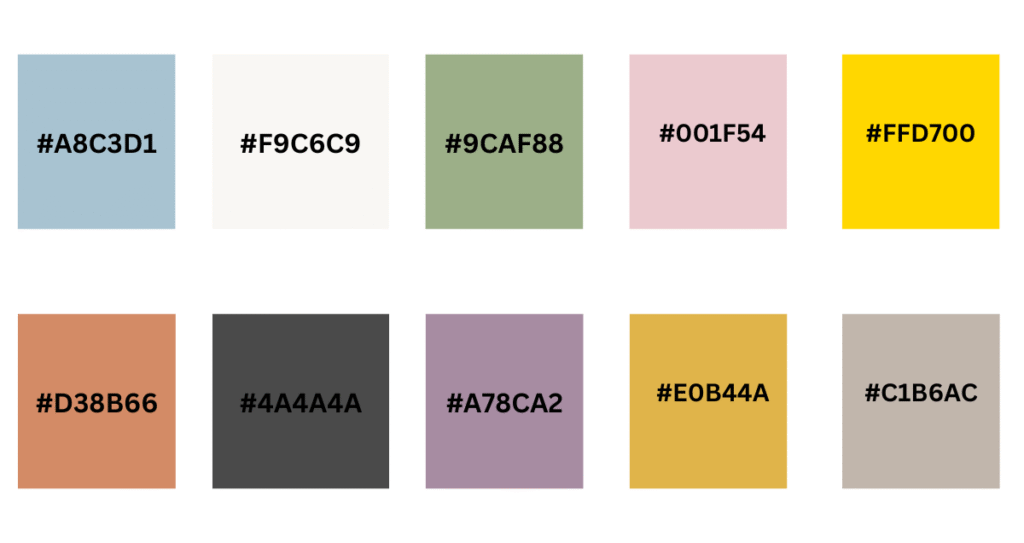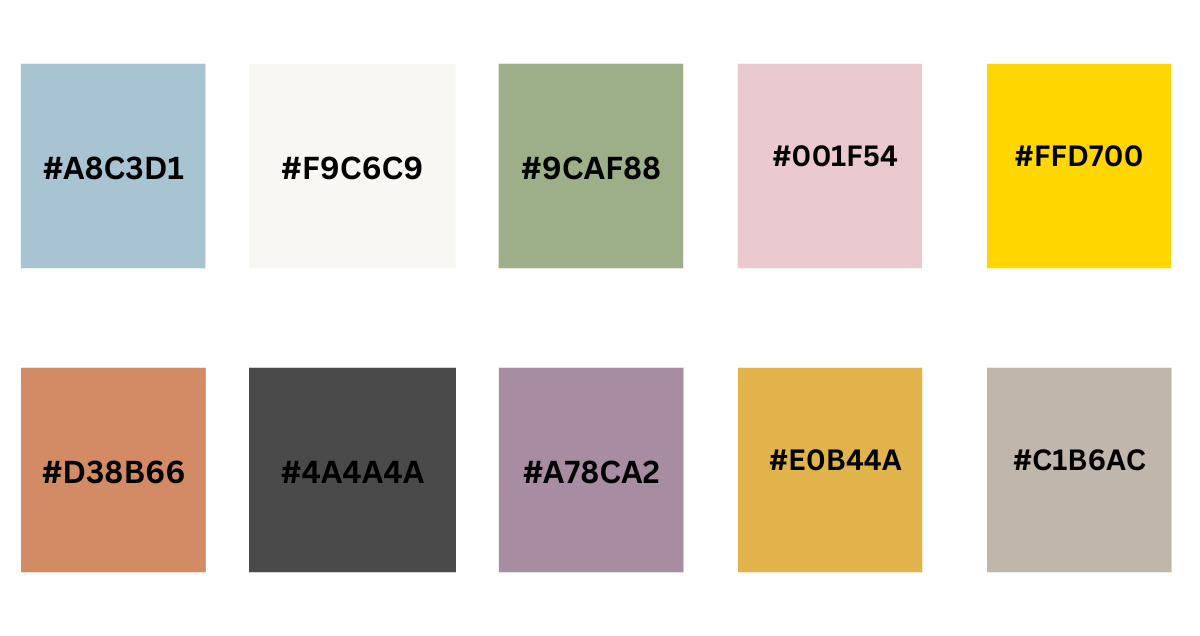If you’re building a brand and want a color that feels calm, polished, and trustworthy, dusty blue is a smart choice. This muted blue with gray undertones strikes the perfect balance between classic and contemporary — which is why it’s everywhere in 2025 branding: from personal blogs to tech startups.
But dusty blue rarely works best on its own.
To make your brand truly stand out, it’s all about choosing the right colors to pair with it. In this guide, you’ll find new and research-based dusty blue color combinations ideal for logos, websites, and packaging — with HEX codes and use case tips. These combinations aren’t just pretty; they’re rooted in design psychology and current trends.
Why Dusty Blue Is a Branding Power Color
Dusty blue is versatile because it blends the emotional strength of blue with the neutrality of gray. It’s soft without being passive, sophisticated without being cold.
Psychological benefits of dusty blue:
- Inspires trust and reliability (like traditional blue)
- Feels serene and safe — especially in wellness or creative brands
- Balances feminine and masculine tones, making it gender-neutral
Where it works well:
- Branding for skincare, weddings, design studios, tech, and minimalist blogs
- Web design for lifestyle, editorial, and eCommerce sites
- Logo designs that need to communicate calm authority
Let’s now dive into updated, thoughtfully chosen color combinations for 2025.

Top 12 Dusty Blue Color Combinations (With Real Branding Use Cases)
1. Dusty Blue + Warm Ivory
- Look: Elegant, timeless, calm
- HEX: #A1B5C1 (Dusty Blue) + #F6F1EB (Warm Ivory)
- Best For: Wedding planners, lifestyle coaches, heritage brands
This soft pairing is the updated version of blue-and-white. The ivory adds warmth, avoiding the starkness of pure white. It’s especially strong when used in logo marks and packaging for wellness products.
2. Dusty Blue + Smoky Plum
- Look: Creative, moody, upscale
- HEX: #A1B5C1 + #7A5C68
- Best For: Photography studios, boutique brands, interior design
This combo plays with warm and cool tension. Smoky plum brings depth to the softness of dusty blue. Used well in hero sections or editorial-style website layouts.
3. Dusty Blue + Linen Beige
- Look: Understated, cozy, grounded
- HEX: #A1B5C1 + #D8CAB6
- Best For: Home brands, eco-labels, minimalist creatives
Linen beige brings a cozy, earthy softness that works beautifully on neutral backgrounds. Try this for natural skincare or handmade product brands.
4. Dusty Blue + Copper
- Look: Luxurious, bold, high-end
- HEX: #A1B5C1 + #B97348
- Best For: Fashion, jewelry, and luxury packaging
Copper is trending in 2025 for its organic metallic appeal. Paired with dusty blue, it elevates without being flashy. Great for product labels or luxury branding.
5. Dusty Blue + Dried Rose
- Look: Feminine, romantic, nostalgic
- HEX: #A1B5C1 + #C68A8B
- Best For: Bridal shops, floral brands, vintage style blogs
Dried rose is a muted pink-red that harmonizes emotionally with dusty blue. Together, they feel romantic and a little nostalgic — a perfect wedding color palette.
6. Dusty Blue + Modern Tan
- Look: Sophisticated, editorial, clean
- HEX: #A1B5C1 + #CBB49A
- Best For: Fashion bloggers, lifestyle platforms, aesthetic studios
A soft modern tan acts as a warm neutral anchor. It gives the airy, editorial look that many Instagram-first brands are seeking right now.
7. Dusty Blue + Clay Brown
- Look: Earthy, natural, artsy
- HEX: #A1B5C1 + #AF8570
- Best For: Sustainable brands, ceramic shops, artisan goods
This grounded color combo feels like nature and craft. It works well in earthy brand storytelling — especially for packaging and handmade goods.
8. Dusty Blue + Olive Green
- Look: Balanced, fresh, earthy
- HEX: #A1B5C1 + #8C9B75
- Best For: Gardening brands, eco-businesses, health tech
Olive green adds structure and depth. This pairing is masculine enough for tech but soft enough for nature-inspired designs.
9. Dusty Blue + Buttermilk Yellow
- Look: Cheerful, modern, optimistic
- HEX: #A1B5C1 + #F6E7A6
- Best For: Children’s brands, handmade goods, boutique shops
This soft yellow feels bright without overpowering the blue. It’s playful and warm — great for creative studios or branding that wants a sunny vibe.
10. Dusty Blue + Charcoal Black
- Look: Bold, clean, powerful
- HEX: #A1B5C1 + #2E2E2E
- Best For: Tech, architecture, UX agencies
Charcoal is a modern classic. When paired with dusty blue, it creates an ultra-professional yet visually interesting contrast. Use it for typography-heavy websites or black-and-blue logo marks.
11. Dusty Blue + Apricot Peach
- Look: Playful, fresh, indie
- HEX: #A1B5C1 + #F2BBA5
- Best For: Creatives, small eCommerce shops, social media visuals
Apricot peach adds warmth and approachability. This is a great palette for brands targeting younger, trend-conscious audiences.
12. Dusty Blue + Classic White + Graphite Gray
- Look: Minimal, timeless, confident
- HEX: #A1B5C1 + #FFFFFF + #5A5A5A
- Best For: Personal brands, portfolios, service-based websites
This triadic combo gives you range. White offers freshness, dusty blue brings identity, and graphite adds contrast. It’s also print-safe and easy to use across all platforms.
How to Choose the Right Combo for Your Brand
Dusty blue combinations can go in many directions: romantic, modern, minimal, bold. But choosing the right one depends on your brand goals:
Ask yourself:
- What do I want my audience to feel?
Trust? Calm? Excitement? Neutral colors bring calm. Richer ones bring drama. - What industry am I in?
Beauty or fashion might go well with gold, blush, or tan. Tech? Go darker. - Where will my colors appear most?
Print materials, online stores, app interfaces — each platform behaves differently. - Is your brand feminine, masculine, or neutral?
Dusty blue sits in the middle, so your secondary color can push your brand either way.
Bonus: Try These Free Tools to Visualize Your Palette
- ✅ Dusty Blue Color Palette Generator – Curated combos made for designers
- ✅ Coolors.co – Auto-generate and lock in custom combos
- ✅ Canva – Visual palette builder with branding previews
- ✅ Adobe Color – Great for color theory-based harmony
FAQs
Can dusty blue be used as a primary brand color?
Yes! It’s calming, stylish, and works well as a primary hue — especially when paired with a bold accent.
What’s the best dusty blue HEX code?
A great standard is #A1B5C1, but you can go slightly darker or lighter depending on your brand tone.
Does dusty blue work for masculine brands?
Absolutely. Combine it with charcoal, navy, olive, or taupe for a more grounded feel.
What if I want a minimalist palette?
Pair dusty blue with white, soft gray, or beige for a clean, airy look.
Can dusty blue work in bold branding?
Yes. Add copper, black, or plum to give it stronger contrast and edge.
Final Thoughts
Dusty blue is a quiet powerhouse in design — timeless, flexible, and emotionally intelligent. When combined with the right accent colors, it can shape how your audience feels, remembers, and trusts your brand.
Use these updated combinations as a starting point to build a visual identity that’s calm, confident, and completely your own.
👉 Explore more palettes or build your own with the Dusty Blue Color Palette Generator
Hi, I’m Anwar Malik — a design lover and website creator who’s always been drawn to soft, timeless colors like dusty blue. I started this site to share ideas and inspiration for anyone who loves using calm, elegant tones in fashion, decor, or events.
With my background in web development and visual styling, I enjoy turning color ideas into helpful content. Whether you’re planning a wedding or just looking for styling tips, I hope you find something useful and beautiful here.
